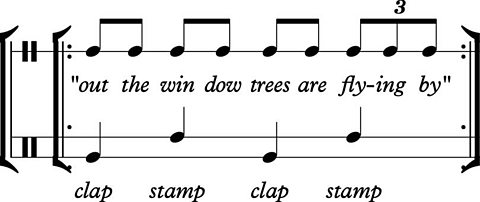For:
- Key Stage 2 in England and Wales
- Second Level, P5-P7 in Scotland
- Key Stage 1/Key Stage 2 in Northern Ireland
You can also download the lesson plans as a PDF with accompanying powerpoint slides.
Written by Rachel Leach
Background
The composer: George GERSHWIN (1898тАУ1937)
- American composer and pianist
- A hugely famous songwriter from the age of 19 and, with his brother Ira, wrote some of the most famous songs of the 20th century
Explore and download lesson plans for six weeks of learning and activities for Rhapsody in Blue by George Gershwin.

The music: Rhapsody in Blue (excerpt)
- Written in 1924 for a crossover concert featuring classical music and jazz
- Gershwin was reluctant to write it until the very last minute. It was then orchestrated by his friend Ferde Grofe
- Features a very famous clarinet solo at the beginning which was improvised during rehearsals and a huge solo piano part originally played by Gershwin himself тАУ most of this was improvised during the first performance
- Many of the ideas came to Gershwin during a train journey. His aim was to describe the spirit of 1920s America
Trailblazer: American composer George Gershwin brought the sounds of jazz and blues into the classical music concert hall for the first time!
Explore and download powerpoint slides for six weeks of learning and activities for George Gershwin тАУ Rhapsody in Blue (excerpt).

Learning outcomes
Learners will:
- listen and reflect on a piece of orchestral music
- create their own piece of music using instruments and voice
- perform as an ensemble
- learn musical language appropriate to the task
Curriculum checklist:
- play and perform in ensemble contexts, using voices and playing musical instruments
- improvise and compose music for a range of purposes using the interrelated dimensions of music
- listen with attention to detail and recall sounds with increasing aural memory
Glossary of music terms used:
- Dynamics - the term used for volume (louds and softs)
- Motif - a very short musical тАШideaтАЩ тАУ often just a sound or a rhythm
- Pitched percussion - percussion instruments that can play different pitches тАУ xylophones, glockenspiels, chime bars, etc.
- Soundscape - a musical collage of sounds often free flowing without an underlying beat or pulse
- Tempo - another word for speed
Glossary terms can be found in bold throughout.
Resources required:
- classroom percussion instruments
- paper and pens
This scheme of work is plotted out over six lessons. Feel free to adapt it to suit your children and the resources you have available.
The six lessons at a glance
Lesson 1:
Activities:
- Watch the film
- Listen to the performance
- Draw a cityscape
Curriculum link:
- Listen with attention to detail and recall sounds with increasing aural memory
- Use and understand staff and other musical notations
- Appreciate and understand a wide range of high-quality live and recorded music drawn from different traditions and from great composers and musicians
- Develop an understanding of the history of music
Lesson 2:
Activities:
- Make a list of the sounds around school
- Describe them and make musical motifs from these descriptions
Curriculum link:
- Listen with attention to detail and recall sounds with increasing aural memory
- Improvise and compose music for a range of purposes using the interrelated dimensions of music
Lesson 3:
Activities:
- Structure motifs into a piece
Curriculum link:
- Listen with attention to detail and recall sounds with increasing aural memory
- Improvise and compose music for a range of purposes using the interrelated dimensions of music
- Play and perform in solo and ensemble contexts, using their voices and playing musical instruments with increasing accuracy, fluency, control and expression
Lesson 4:
Activities:
- Learn and invent тАШtrainтАЩ rhythms (ostinatos)
Curriculum link:
- Listen with attention to detail and recall sounds with increasing aural memory
- Play and perform in solo and ensemble contexts, using their voices and playing musical instruments with increasing accuracy, fluency, control and expression
- Improvise and compose music for a range of purposes using the interrelated dimensions of music
Lesson 5:
Activities:
- Learn about the blues scale
- Invent a tune
- Use technical terminology where appropriate
Curriculum link:
- Listen with attention to detail and recall sounds with increasing aural memory
- Play and perform in solo and ensemble contexts, using their voices and playing musical instruments with increasing accuracy, fluency, control and expression
- Improvise and compose music for a range of purposes using the interrelated dimensions of music
Lesson 6:
Activities:
- Structure sections of music into a bigger piece
- Perform in a concert
Curriculum link:
- Play and perform in solo and ensemble contexts, using their voices and playing musical instruments with increasing accuracy, fluency, control and expression
- Improvise and compose music for a range of purposes using the interrelated dimensions of music

LESSON 1 - Watching and listening
- Prepare your class
Explain to your class that you are going to begin a six-week music project focusing on a fantastic piece of music by a composer called George Gershwin.
Explain further that Gershwin was American and writing music at the start of the 20th century during a time when jazz was becoming popular. His piece, тАШRhapsody in BlueтАЩ is said to sound like his home town of New York City.
- Watch, or listen to the very famous opening (just the clarinet slide, for about 20 seconds). Tell your children that this is describing something in the city, something we still hear a lot in cities today. Can they guess what it is? Have a discussion and perhaps collate some of their ideas on the board. Tell them that all of their suggestions are correct because it is simply what they think of when they hear the music, however Gershwin himself thought the clarinet sounded like a wail and it is similar to todayтАЩs police sirens.
Pianist Lauren Zhang joins the │╔╚╦┬█╠│ Scottish Symphony Orchestra to perform GershwinтАЩs Rhapsody in Blue.
- Listening task
Listen or watch the full orchestra performance. As you do so ask the children to imagine they are in a bustling city. You might want to show them images of the skyscrapers of Manhattan or the London skyline before you start. Their task is to draw what they hear тАУ what is the music describing? Encourage them to use their imagination, they are drawing a city with all its rushing people, transport, noise and what Gershwin called тАШmetropolitan madnessтАЩ. They are not drawing the orchestra and its players and instruments.
This │╔╚╦┬█╠│ Ten Pieces version of the piece lasts for about six minutes so you could listen two or three times back to back as the children draw.
- Feedback
Ask for volunteers to show their work to the rest of the class and then make a list of similarities and differences between everyoneтАЩs artwork. If you have time, watch the performance once again without drawing so that you can fully focus on the orchestra.
- FINALLY, end your session by watching the │╔╚╦┬█╠│ Ten Pieces Trailblazers film.
George GershwinтАЩs Rhapsody in Blue is full of the sounds and energy of 1920s New York. Radzi Chinyanganya introduces the piece and tells us about GershwinтАЩs love of Jazz and Blues.

LESSON 2 - Your city sounds
- Go for a walk!
Take your class on a walk near school or just around the playground. Ask them to be quiet as they walk and really listen to the sounds around them тАУ the sounds of their тАШcityтАЩ.
Stop at a safe place where there is lots to listen to and ask your children to be completely quiet and make a mental list of all the sounds they hear during one minute.
Back in the classroom, split your children into about four or six working groups. Give out paper and pens and ask each team to draw this table:

(you could prepare this in advance to save time)
- Ask each group to make a list of the sounds they heard and provide a short description of them. Were they long? High? Low? Quiet? Rustling? Surprising?
For example -

Ask each group to choose just one sound from their list (make sure that the groups have chosen contrasting sounds) and challenge them to find a way to represent their chosen sound using either voices, classroom percussion instruments or any other instruments/resources you might have. Encourage them to think carefully about what sort of instrumental/vocal sound or combination of sounds is best for what they are describing
FINALLY, ask each group to perform their тАШcity soundтАЩ to the rest of the class and explain that they have created a тАШmusical motifтАЩ just like the clarinet тАШsirenтАЩ at the beginning of Rhapsody in Blue. Encourage each team to quickly write down what they have done and who played what.

LESSON 3 - City soundscape
- Warm-up
Clear your classroom and ask the children to sit on the floor in a big circle. Begin your session with a quick focusing activity: for example pass a clap and other quiet sounds, such as тАШshhтАЩ around the circle.
Split back into your groups and allow about five minutes for each group to put their тАШcity soundтАЩ back together from last lesson. Make sure that everyone has the same instrument as last time and recreates what they did then rather than switching or creating something new.
Bring the class back together and hear each group in turn, giving a bit of feedback as you go through.
Explain that you are going to turn their sounds into a city soundscape. To do this, stand in the middle of the classroom and signal to each group when to start and stop their sound. Then layer up the sounds in various ways to give the impression of a bustling city.
Appoint a conductor to do the signaling for you and encourage her/him to also indicate changes in volume тАУ raising a hand high could mean loud and lowering it, soft. The musical term for this is dynamics. Try out several conductors and encourage the players to give gentle feedback after each one.
FINALLY, fix the structure. Ask your class to create an order for their sounds and write this up on the board as a list of events. Challenge them to perform it without a conductor and again, give them some feedback. Name this piece тАШCity SoundscapeтАЩ and make a note of the structure and who does what. Keep it safe, you will need it later on in the project.

LESSON 4 - Train rhythms
- Warm-up
As usual, begin in a large circle with a quick focusing activity and (spoken) reminder of what happened during the last session.
Explain that GershwinтАЩs piece came to him whilst he was on a train. The rhythms of the train gave him all of his ideas and you can hear some of those rhythms within his music.
Remaining in a circle, demonstrate this pulse:

тАжand encourage your children to join in. Try to keep a steady tempo (speed) тАУ not too fast.
- Choose two children to select two contrasting instruments to play this pulse. One тАШweakтАЩ and one тАШstrongтАЩ. The тАШweak instrument plays the first (clapped) beat, perhaps like this:

Practise this at the same time as the body percussion version so that everyone is joining in.
- Demonstrate this rhythm:

(Saying the words will help with the rhythm)
This rhythm is tricky to play without speeding up. It might help to split it between two players, like this:

Choose another two children to select instrument/s to play this and encourage them to play it while everyone else joins in on body percussion.
Now, try the two rhythms together. Like this:

If the second rhythm is proving too challenging, feel free to simplify it or encourage the group to make up their own rhythm using this simple method:
- Ask them a question such as тАШwhat do you see out of the train window?тАЩ
- Clap their answer to the pulse
Split back into your groups from last lesson and ask each group to practise these train rhythms on instruments. They should use the same instruments from the тАШCity SoundscapeтАЩ activity if possible and if you want to use additional instruments make sure they are тАШnewтАЩ and not just borrowed from elsewhere in the piece.
Finally, bring the class back together and hear each group one by one. Ask them to work out how to layer up the groups to create one big piece and write down the order/structure of this. End the session by playing this new тАШtrainтАЩ piece and donтАЩt worry if itтАЩs messy at this stage.

LESSON 5 - Bluesy tune
Begin with a gentle warm-up and a reminder of last week. DonтАЩt get out the instruments at this stage but do clap/tap the train rhythms and practise the order you decided on. You can also remember the тАШCity SoundscapeтАЩ using just voices, body percussion and actions.
Explain that in тАШRhapsody in BlueтАЩ, Gershwin was trying to join together classical music and jazz music. To do this he wrote some really clever melodies using a special set of notes called the тАШblues scaleтАЩ. Many of his tunes were improvised тАУ i.e. made up on the spot.
Demonstrate.
Using a white-note xylophone, improvise a short melody using these rules from George Gershwin.
GershwinтАЩs tune:
- Starts high and moves downwards (i.e. move from top C to bottom C)
- Uses next-door notes (i.e. no jumping around!)
You might end up with something like this:

Keep things simple by playing really slowly and steadily.
Ask a volunteer to try. Did they follow the rules? Try out several children until you have a melody you all like. This will be the basis of your class tune.
Next, replace some of the white notes with black notesтАж
Xylophones often come with alternate notes тАУ typically Bb and F#. If you can find these underused notes, simply swap them for the corresponding white note. So, take off F, replace with F# etc.
Your resulting scale will be C, D, E, F#, G, A, Bb
тАжand play your melody again. So you might have something like this:

Write this on the board in a way that your children understand (i.e. probably just the note names).
Explain that in jazz, these sharps and flats are known as тАШblueтАЩ notes and the resulting tune is known as тАШbluesyтАЩ.
Split back into your small working groups and give out as many xylophones as you have with the added тАШbluesтАЩ notes on тАУ at least one to each group. Challenge each player to learn and practise the class tune, the other children in each group can help, or play the pulse to keep the rhythms steady.
If you are running short of xylophones, you can do this task with chromatic glockenspiels тАУ to make the tune тАШbluesyтАЩ the player must move diagonally to a sharp or flat. It can also be done on the piano using the same method. If you have beginner musicians (flutes, violins, etc.) simply challenge them to add a F# instead of an F тАУ this is often the first тАШsharpтАЩ children learn.
- FINALLY, end the session by putting all the melodies together so you have one melody played by everyone with other players providing the pulse. If you have time, try adding the train rhythms to this too and again, donтАЩt worry if it sounds messy at this stage.

LESSON 6 - Performance time!
- Prepare your class
Sit the children in a circle and recap all of the elements you have created so far, using just voices and body percussion. You should have all of this:
- City Soundscape тАУ layered up, possibly conducted
- Train rhythms тАУ in groups with a structure
- Bluesy tune тАУ played by several people across all groups, perhaps with the train rhythms or a pulse underneath
Get the instruments out and split back into groups. Give the class just five minutes to put their music back together тАУ all three elements.
Hear each group and put the sections back together.
Ask the class how to structure these three sections into one piece. Time is short so you want the simplest answer here, something like:
- City Soundscape тАУ gets louder, stops abruptly
- Train rhythms begin тАУ group by group, then everyone
- Melody on top, train rhythms continue
- Fade away
Practise this structure, your full piece, until it is neat and everyone knows what they are doing.
FINALLY, invite another class to hear your music. Ask them afterwards what the music made them think of and tell them about GershwinтАЩs тАШRhapsody in BlueтАЩ.

TAKING IT FURTHER - Cross-curricular activities
MUSIC: Gershwin influenced many other composers including Copland and Bernstein тАУ both have pieces featured in the │╔╚╦┬█╠│ Ten Pieces project. GershwinтАЩs next big orchestral piece was тАШAn American in ParisтАЩ which is similarly about a city and features the sounds of actual Paris taxi cabs.
POETRY: use your list and descriptions of city sounds to create poetry about your city.
LITERACY: Take an imaginary train journey and write a journal about your adventure. Talk about the train, what you see out of the window and your dream destination. You could even time-travel to visit GershwinтАЩs New York City of 1924.
UPLOAD: Show us what youтАЩve created! Submit your creative responses using our Uploader for a chance to be featured on the Ten Pieces website.
Upload and showcase your creative responses
Upload your creative responses to the Ten Pieces repertoire for your chance to feature in the Ten Pieces creative showcase.
